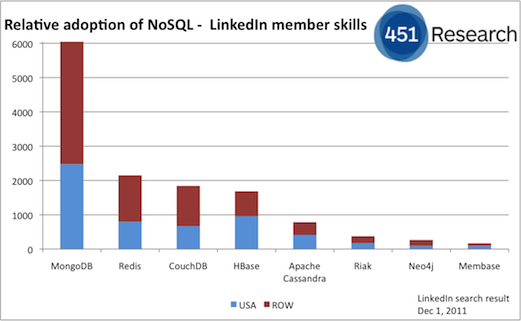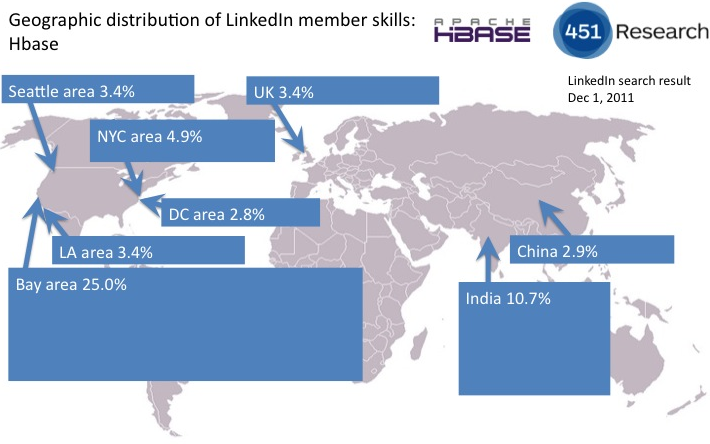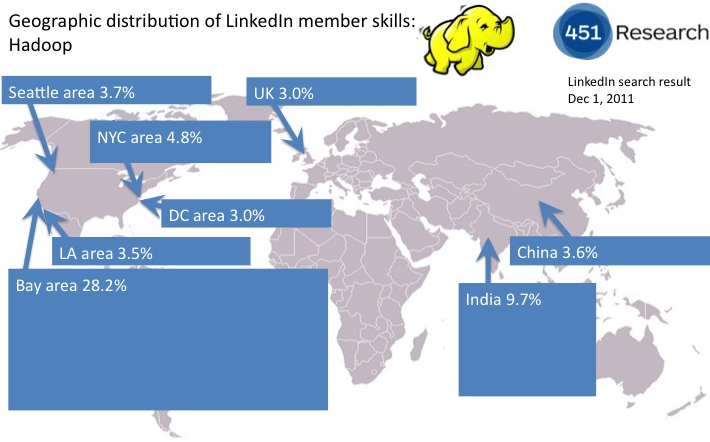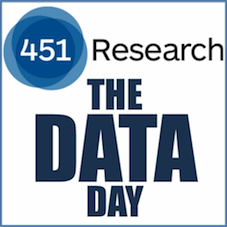March 27th, 2012 — Data management
Back in December we ran a series of posts looking at the geographic distribution of NoSQL skills, according to the results of searching LinkedIn member profiles, culminating in a look at the relative overall popularity of the major NoSQL databases.
This week I took another look at LinkedIn to update the results for a forthcoming report, which gives us the opportunity to see how the results have changed over the past quarter:

While this provides us with an interesting opportunity to track LinkedIn profile mentions over time there isn’t a huge amount we can learn from this first update – other than that MongoDB seems to be increasing its dominance.
The only significant change that isn’t immediately obvious from looking at the chart is that Apache HBase has overtaken Apache CouchDB by a tiny margin to claim third place overall.
As we noted last time, however, Apache HBase is more reliant on the US than other NosQL databases for its LinkedIn mentions: it is the second most prevalent NoSQL database mentioned in the USA but fourth in the rest of the world.
Two other points to take into consideration:
– The results for Apache Cassandra are probably disproportionately low since we have to search for the full phrase in order to avoid including people called Cassandra.
– Previously we only searched for Membase. This time we added together the search results for both Membase and Couchbase. This may mean the result for Couch/Membase is disproportionately high since some members probably listed both.
This is not meant to be a comprehensive analysis, however, but rather a snapshot of one particular data source.
January 30th, 2012 — Data management
I put this slide together for my own benefit as I was trying to keep track of the various incarnations of Couchbase’s brands. Looks like I wasn’t the only one, so I thought I’d also make our perspective available.
There are a couple of differences between our slide and Koji Kawamura’s:
Ours contains an extra layer of names (e.g. “Elastic Couchbase”) that were briefly used by Couchbase in discussion and I believe in marketing, although never for shipping product.
Also ours doesn’t mention memcached. It could be on there given that Membase is based on it, and Couchbase Server can still be deployed in “memcached only mode”, but in that sense it is a feature of Membase/Couchbase Server. And anyway, I couldn’t fit it on 🙂

January 24th, 2012 — Data management
December 12th, 2011 — Data management
Hidden away amongst the details of our little tour around LinkedIn statistics on NoSQL and Hadoop skills was some interesting information on how many LinkedIn members list the various data management technologies in our sample in their profiles.
Our original post contained the fact that there were 9,079 LinkedIn members with “Hadoop” in their member profiles, for example, compared to 366,084 with “MySQL” in their member profiles.
Later posts showed there were 170 with “Membase” and 1,687 with “HBase”, 787 with “Apache Cassandra” and 376 with “Riak”, 6,048 with “MongoDB” and 2,152 with “Redis”, and finally, 1,844 with “CouchDB” and 268 with “Neo4j”.
This gives us an interesting perspective on the relative adoption of the various NoSQL databases:

If it wasn’t already obvious from the list above, the chart illustrates just how much more prevalent MongoDB skills are compared to the other NoSQL databases, followed by Redis, Apache CouchDB, Apache HBase and Apache Cassandra. The chart also illustrates that while HBase is the second most prevalent NoSQL skill set in the USA, it is only fourth overall given its lower prevalence in the rest of the world.
In response, a representative from a certain vendor notes “Some skills are more valued not because they are more prevalent, but because they are harder to achieve.” Make of that what you will.
December 5th, 2011 — Data management
Following last week’s post putting the geographic distribution of Hadoop skills, based on a search of LinkedIn members, in context, this week we will be publishing a series of posts looking in detail at the various NoSQL projects.
The posts examine the geographic spread of LinkedIn members citing a specific NoSQL database in their member profiles, as of December 1, and provides an interesting illustration of the state of adoption for each.
We begin this week’s series with Membase and HBase, the two projects that proved, like Apache Hadoop, to have significantly greater adoption in the USA compared to the rest of the world.
The statistics showed that 58.2% of the 170 LinkedIn members with “Membase” in their member profiles are based in the US (as previously explained, we tried the same search with Couchbase, but with only 85 results we decided to use the Membase result set as it was more statistically relevant).
As with Hadoop, a significant proportion (27.1%) of those are in the Bay area, the highest proportion of all the NoSQL databases we looked at. The results also indicate that Ukraine is a hot-spot for Membase skills, with 3.5%, while Membase adoption is lower the UK (2.4%) than other NoSQL databases.

It should not be a great surprise that Apache HBase returned similar results to Apache Hadoop. The top eight individual regions for HBase were exactly the same as for Hadoop, although the UK (3.4%) is stronger for HBase, as is India (10.7%).
The statistics showed that 57.0% of the 1,687 LinkedIn members with “HBase” in their member profiles are based in the US, with 25.0% in the Bay area (the third highest in our sample behind Hadoop and Membase).

The series will continue later this week with MongoDB, Riak, CouchDB, Apache Cassandra, Neo4j, and Redis.
N.B. The size of the boxes is in proportion to the search result (click each image for a larger version). World map image: Owen Blacker
December 2nd, 2011 — Data management
NC State University’s Institute for Advanced Analytics recently published some interesting statistics on Apache Hadoop adoption based on a search of LinkedIn data.
The statistics graphically illustrate what a lot of people wer already pretty sure of: that the geographic distribution of Hadoop skills (and presumably therefore adoption) is heavily weighted in favour of the USA, and in particular the San Francisco Bay Area.
The statistics showed that 64% of the 9,079 LinkedIn members with “Hadoop” in their member profiles (by no means perfect but an insightful measure nonetheless) are based in the US, and that the vast majority of those are in the Bay Area.
The results are what we would expect to see given the relative level of immaturity of Apache Hadoop adoption, as well as the nature and location of the early Hadoop adopters and Hadoop-related vendors.
The results got me thinking two things:
– how does the geographic spread compare to a more maturely adopted project?
– how does it compare to the various NoSQL projects?
So I did some searching of LinkedIn to find out.
To answer the first question I performed the same search for MySQL, as an example of a mature, widely-adopted open source project.
The results show that just 32% of the 366,084 LinkedIn members with “MySQL” in their member profiles are based in the US (precisely half that of Hadoop) while only 4.4% are in the Bay area, compared to 28.2% of the 9,079 LinkedIn members with “Hadoop” in their member profiles.
The charts below illustrate the difference in geographic distribution between Hadoop and MySQL. The size of the boxes is in proportion to the search result (click each image for a larger version).


With regards to the second question, I also ran searches for MongoDB, Riak, CouchDB, Apache Cassandra*, Membase*, Neo4j, Hbase, and Redis.
I’ll be posting the results for each of those over the next week or so, but in the meantime, the graphic below shows the split between the USA and Rest of the World (ROW) for all ten projects.
It illustrates, as I suspected, that the distribution of skills for NoSQL databases is more geographically disperse than for Hadoop.
I have some theories as to why that is – but I’d love to hear anyone else’s take on the results.

*I had to use the ‘Apache’ qualifier with Cassandra to filer out anyone called Cassandra, while Membase returned a more statistically relevant result than Couchbase.
World map image: Owen Blacker
February 17th, 2011 — Data management
Next Thursday, February 24 (at 10am PT), I’ll be taking part in a webinar with Pero Subasic, Chief Architect, AOL to discuss the use cases for NoSQL database and Hadoop.
More specifically, Pero will be presenting how AOL Advertising leverages Hadoop and Membase NoSQL database technology to rapidly process operational user data to achieve sub-millisecond performance. Before that, I will be providing some context with a presentation about the changing data management landscape, the drivers behind the adoption of NoSQL databases and Hadoop, and their respective use cases.
My presentation provides a sneak peak into our ongoing research into the drivers and use cases for emerging database technologies, which will be delivered in a new long format report due in early April.
Following Pero’s presentation we will be joined by executives from Couchbase and Cloudera to answer any questions. You can register for the event here, while Couchbase’s James Phillips has provided a taster of what to expect here.
February 8th, 2011 — Data management, M&A
The predicted consolidation of the NoSQL database landscape has begun. Membase and CouchOne have announced that they are merging to form Couchbase.
And in more interesting NoSQL news, Danish IT company Trifork has announced that it has acquired an 8% stake in Basho as part of the NoSQL vendor’s $7.4m series D round, and has become the European distributor for Riak.
The formation of Couchbase brings together to of the leading companies in the NoSQL space, and the complementary nature of the their technology and business plans highlights that the term NoSQL has been applied to many different database technologies which are being adopted for different reasons.
While Membase had focused on improving the performance of distributed applications through its Membase Server distributed database, CouchOne focused on developer interest in flexible document data stores and mobile applications, rather than performance at scale.
Additionally while Membase was focused on operational adoption with a small (albeit significant) developer community, the priority with CouchOne has been on growing adoption of Apache CouchDB, with commercial efforts only recently becoming the focus of attention.
The technology is also complementary. Couchbase will combine the Membase and CouchDB projects to form a new distributed document store project of the same name that combines the caching and clustering technology of Membase with the CouchDB document data store.
The result will be a new distributed document database covering a variety of use cases from mobile applications (Mobile Couchbase) to scalable clusters (Elastic Couchbase), with synchronization of data between the various Couchbase implementations enabled by CouchSync.
The merged company will be led by Bob Weiderhold, formerly CEO of Membase, while Damien Katz, formerly CEO of CouchOne and creator of the CouchDB database, becomes CTO.
Couchbase is claiming more than 200 customers, which would indicate phenomenal growth for both companies since the launch of their CouchOne Mobile and Membase Server products in September and October 2010 respectively.
Prior to the launch of those products they previously claimed just a handful of customers each, although CouchOne had signed up thousands of users to its free hosted services, so it had a large and willing audience ready for conversion.
Additionally the company claims millions of combined users since CouchDB has been included in every installation of the Ubuntu Linux distribution since late 2009 and Heroku (now part of Salesforce.com) offers a Membase-driven service to thousands of its hosting customers.
We previously predicted that we would see the NoSQL market both consolidate and proliferate this year, and it is worth noting that the merger of CouchOne and Membase will not result in a similar consolidation of open source projects.
While Couchbase.org can be expected to replace membase.org over time, the Couchbase project will be independent of the Apache CouchDB, which will not be impacted by the merger. Couchbase will continue to contribute to both CouchDB and also the memcached project.
While we’re on the subject of NoSQL, it is also interesting to see that Danish IT vendor Trifork has not only signed up to be European distributor of the Riak database, but has also taken a stake in Basho Technologies.
Trifork has acquired newly issued shares in Basho representing 8.35% of the company as part of its series D round, with an option to acquire an additional 3.96% at the end of Q1 2011.
March 15th, 2010 — Data management
One of the essential problems with the covering the NoSQL movement is that it describes not what the associated databases are, but what they are not (and doesn’t even do that very well since SQL itself is in many cases orthogonal to the problem the databases are designed to solve).
It is interesting to see fellow analyst Curt Monash facing the same problem. As he notes, while there seems to be a common theme that “NoSQL is Foo without joins and transactions,” no one has adequately defined what “Foo” is.
Curt has proposed HVSP (High-Volume Simple Processing) as an alternative to NoSQL, and while I’m not jumping on the bandwagon just yet, it does pass the Ronseal test (it does what it says on the tin), and it also matches my view of what defines these distributed data store technologies.
Some observations:
I agree with Curt’s view that object-oriented and XML databases should not be considered part of this new breed of distributed data store technologies. There is a danger that NoSQL simply comes to mean non-relational.
I also agree that MapReduce and Hadoop should not be considered part of this category of data management technologies (which is somewhat ironic since if there is any technology for which the terms NoSQL or Not Only SQL are applicable, it is MapReduce).
The vendors associated with the NoSQL movement (Basho, Couchio and MongoDB) are in a problematic position. While they are benefiting from, and to some extent encouraging, interest in NoSQL, the overall term masks their individual benefits. My sense is they will look to move away from it sooner rather than later.
Memcached is not a key value store. It is a cache. Hence the name.
.
There are numerous categorizations of the various NoSQL technologies available on the Internet. Without wishing to add yet another to the mix, I have created another one – more for my benefit than anything else.
It includes a list of users for the various projects (where available), and also some sense of whether the various projects fit into CAP Theorem, an understanding of which is, to my mind, essential for understanding how and why the NoSQL/HVSP movement has emerged (look out for more on CAP Theorem in a follow-up post on alternatives to NoSQL).
Here’s my take, for those that are interested. As you can see there’s a graph database-shaped whole in my knowledge. I’m hoping to fill that sooner rather than later.
By the way, our Spotlight report introducing The 451 Group’s formal coverage of NoSQL databases will be available here imminently.
Update: VMware has announced that it has hired Redis creator Salvatore Sanfilippo, and is taking on the Redis key value store project. The image below has been updated to reflect that, as well as the launch of NorthScale’s Membase.












 Subscribe via RSS
Subscribe via RSS